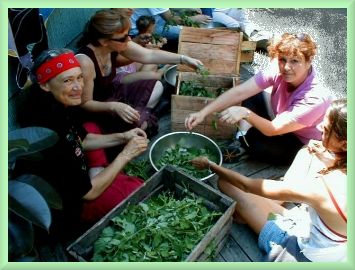
Susun with Wise Woman students, preparing
wild greens salad
I always say the gardener's best revenge is to eat the weeds.
I've been doing it for thirty years and can testify that my
health and the health of my garden has never been better.
Here are a few hints for gardeners who'd rather eat their
weeds than hate them (and for non-gardeners who are adventurous
enough to try out nature's bounty).
View your weeds as cultivated plants; give them the same care
and you'll reap a tremendous harvest. Harvest frequently and
do it when the weeds are young and tender. Thin your weeds
and pinch back the annuals so your weeds become lushly leafy.
Use weeds as rotation crops; they bring up subsoil minerals
and protect against many insects. "Interplant" (by
not weeding out) selected weeds; try purslane, lamb's quarters,
or amaranth with your corn, chickweed with peas/beans, and
yellow dock, sheep sorrel, or dandelion with tomatoes. And,
most importantly, harvest your weeds frequently, regularly,
and generously.
Overgrown radishes, lettuces, and beans are tough and bitter.
So are weeds that aren't harvested frequently enough. Give
your chickweed a haircut (yes! with scissors) every 4-7 days
and it will stay tender all spring, ready to be added to any
salad. If you forget a patch for two weeks, it may get stringy
and tough and full of seed capsules. (All is not lost at this
stage. The seeds are easy to collect – put the entire
plant in a plastic bag in the refrigerator for 2-3 days and
use the seeds that fall to the bottom of the bag – and
highly nutritious, with exceptional amounts of protein and
minerals.)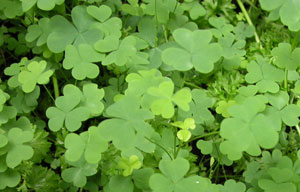
Unthinned carrots and lettuces grow thin and spindly; so do
unthinned lamb's quarters, amaranth, and other edible weeds.
Wherever you decide to let the weeds grow, keep them thinned
as you would any plant you expect to eat. Here's how I do
it: in early spring I lightly top-dress a raised bed with
my cool-method compost (which is loaded with the seeds of
edible weeds). Over this I strew a heavy coating of the seeds
of lettuces and cresses and brassicas (cultivated salad greens),
then another light covering of shifted compost.
Naturally, weed seeds germinate right along
with my salad greens. When the plants are about two inches
high, I go through the bed and thin the salad greens, pull
out all grasses, smartweeds, cronewort, clear weed, and quick
weed (though the last three are edible, I don't find them
particularly palatable). And, I thin back the chickweed, mallows,
lamb's quarters, amaranth, and garlic mustard and other edible
wild greens.
Keep those annuals pinched back. You wouldn't let your basil
go straight up and go to flower, don't let your lamb's quarter
either. One cultivated lamb's quarter plant in my garden grew
five feet high and four feet across, providing greens for
salads and cooking all summer and a generous harvest of seeds
for winter use.
When a crop of greens has bolted or gone to seed in your garden,
you pull it all out and replant with another crop. Do the
same with your weeds. We eat the greens of garlic mustard
all spring, then pull it out just before it bolts (making
a horseradishy vinegar from the choicest roots) - often revealing
a generous crop of chickweed lurking underneath.
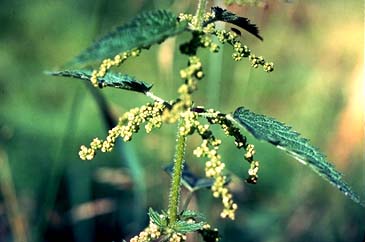
Some of my favorite garden weeds:
ANNUALS
Amaranth (Amaranthus retroflexus)
Young leaves, old leaves, even non-woody stalks are delicious
as a cooked green; chop and boil for 30-40 minutes. Serve
in their own broth; freeze leftovers for winter use. Use instead
of spinach in quiche (you may never grow spinach again). Collect
seeds throughout the autumn by shaking seed heads over a lipped
cookie sheet; or by harvesting and drying the entire seed
head. Winnowing out the chaff is tedious but soothing. There
is a special thrill that comes when you toss the chaffy seed
in the air, and the breeze catches it just-so, and the seeds
fall back into your tray, while the prickly chaff scatters
"to the four winds."
Chickweed (Stellaria media)
Young leaves and stalks, even flowers, in salads. Blend with
virgin olive oil and organic garlic for an unforgettable pesto.
Add seeds to porridge.
Lamb's quarter (Chenopodium alba
and related species, e.g. Chenopodium quinoa)
Young leaves in salads. Older leaves and tender stalks cooked.
Leaves dried and ground into flour (replaces up to half the
flour in any recipe). Seeds dried and cooked in soups, porridge.
Mallows (Malva neglecta and related
species)
Leaves of any age and flowers (the closely related Hibiscus
flowers too!) are delicious in salads. Roots are used medicinally.
Purslane (Portulacca oleracea)
The fleshy leaves and stalks of this plant are incredibly
delicious in salads and not bad at all preserved in vinegar
for winter use.
BIENNIALS
Burdock (Arctium lappa)
Roots of non-flowering plants harvested after frost make a
vinegar that is deep, and richly flavorful as well as a world-renowned
tonic. Petioles of the leaves and the flowering stalk are
also edible; for recipes see my book Healing Wise.
Garlic Mustard (Alliaria officinalis)
Year-round salad green. Leaves used in any season, even winter.
Roots are harvested before plant flowers. Seeds are a spicy
condiment.
Queen Anne's Lace (Daucus carota)
Leaves finely chopped in salads. Flowers are beautiful edible
decorations. Roots of non-flowering plants, harvested in the
fall, and cooked.
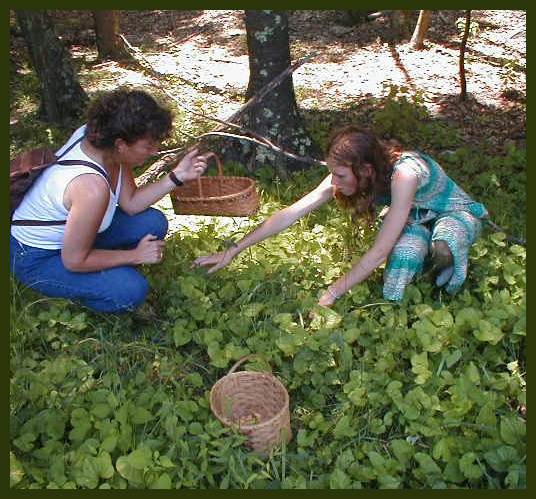
PERENNIALS
Dandelion (Taraxacum officinalis)
Leaves eaten at any time, raw or cooked, but especially tasty
in the fall - not spring! Roots harvested any time; pickle
in apple cider vinegar for winter use. Dandelion flower wine
is justly famous.
Sheep Sorrel (Rumex acetosella)
Leaves add a sour spark to salads. Cooked with wild leeks
or cultivated onion and potato they become a soup called "schav."
Stinging Nettle (Urtica dioica)
Young leaves cooked for 40-45 minutes and served in their
broth are one of my favorite dishes. Seeds can be used in
baked goods, porridge.
Yellow dock (Rumex crispus)
Roots pickled in apple cider vinegar are tasty and a boon
for enriching the blood. Leaves, especially young ones, are
eaten raw or cooked.
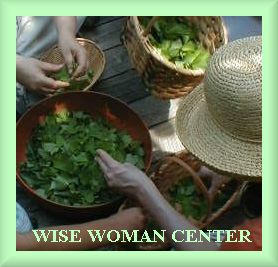
Susun Weed
PO Box 64
Woodstock, NY 12498
Fax: 1-845-246-8081
If you would like to share your knowledge or
read more about nourishing edible weeds
please visit the Real
Foods section of Susun
Weed's Wise Woman Forum
 Needing
a refreshing sweet treat for summertime?
Needing
a refreshing sweet treat for summertime?
Try this recipe from Marie
Summerwood.
LAVENDER SORBET
Serves 4.
9 oz sugar
18 fl oz water
6 lavender heads
juice from one lemon
Stir the sugar into 8 fl oz of the water, in a saucepan, until
the sugar dissolves. Add the lavender heads. Bring to the
boil, then add the juice of half the lemon, and allow to cool.
Strain the liquid through a sieve, to remove the lavender
heads, and add the remaining water. Taste to check the sweetness,
and add more lemon juice if necessary. Put in a freezer-proof
container and still-freeze.
To still-freeze, it's best to use a large shallow container
at first. Pour the liquid in, place it in the coldest part
of the freezer, then wait for at least an hour (it may take
longer depending on the freezer, mine took about 4 hours to
start to freeze) until the mixture is just starting to freeze,
with crystals on it.
Working quickly, put the mixture in the liquidizer or food
processor, give it a quick process, then put it back to keep
freezing. Repeat the processing twice more after another couple
of hours each time. This
breaks up the ice crystals to give a scoopable sorbet. Of
course, if you have an ice-cream maker, you can use that.
Enjoy!
click here to find out more about the really yummy upcoming
workshop,
Priestess
of Her Own Pleasure (August 1st through 3rd, 2003)
with Marie Summerwood and Susun Weed

Women's
Sacred Chants by Marie






 Needing
a refreshing sweet treat for summertime?
Needing
a refreshing sweet treat for summertime? 

